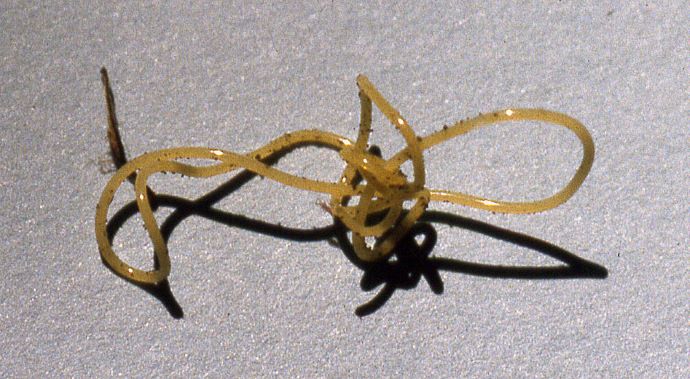
by Kate Redmond
Horsehair worm Redux
Howdy, BugFans,
This is a somewhat rewritten rerun from 2009. New words, no new pictures.
It’s a good thing that the common usage of the term “bug” is so inexact, because once again we are stretching its boundaries to/past the limits.
Horsehair worms are in the Phylum Nematomorpha (which is different from the Nematode worms (https://uwm.edu/field-station/nematodes/). They’re skinny and long; this individual was maybe five inches long, but some species grow to one or two feet long. They have a hard, chitinous covering that, says Ann Haven Morgan in her Field Book of Ponds and Streams, stiffens them so that “in their slow coiling and uncoiling they seem to be so much living wire.” They come in opaque yellow to tan to brown to black colors. They’re wiry and cylindrical, with little tapering at either end (unlike the nearby Nematodes).
Adults live in damp-to-wet habitats from the tropics to the cold-temperate regions. Morgan goes on to say that they “lie like twisted roots or loose-coiled wire, on the bottom of brooks, springs, ponds https://bugguide.net/node/view/183612, watering troughs, and rain-barrels.” Horsehair worms tend to occur in clusters; Pennak, in Fresh-water Invertebrates of the United States, describes them as “a single writhing mass in the springtime.” They look a bit like the snags used to appear on the BugLady’s old casting reel. She doesn’t see them very often – this [picture is an old, scanned color slide.
The adults do not eat – their only function is reproductive. Pennak says that not only is their digestive tract “degenerate and functionless”, they have “no special circulatory, respiratory or excretory structures” (and not much of a brain, either). Their muscle layer runs the long way, making them “slowly undulating swimmers.” But the simplicity of the adults is more than compensated for by their offspring.
Mom lays more than a million (!!!) eggs in a gelatinous string, maybe 8” long, and the string breaks down into smaller pieces and disperses. Soon after they hatch, the microscopic larvae attach to vegetation along the shoreline and form a protective cyst on the plant. When water levels drop, land critters like grasshoppers, crickets, cockroaches, and beetles can reach the aquatic vegetation, and the larvae are inadvertently eaten (“engulfed”) by grazing. They may also be ingested when their host drinks the water, and they can be swallowed by the aquatic immatures of mayflies, dragonflies and caddisflies that escape the water as adults, die, and are eaten by scavenging grasshoppers. Lots of paths.
Once consumed, the cyst dissolves and the larva burrows through the gut wall and into its host, and begins absorbing nutrients from the nearby tissue. Some potential hosts have the ability to encapsulate the cyst with a layer of toxic chemicals after they’ve ingested it.
Mother Nature is careful of the species but careless of the individual – she has produced an exuberance of horsehair worms, and only a vanishingly small percentage will ever find hosts, but that’s enough to keep the species going. An animal that produces that many eggs “expects” a high mortality rate.
When it matures, the larva needs to exit the host’s body, which doesn’t sound like a benign process (although one source said that it’s possible for the host to survive it). It’s best for the larva if the host is near water when this happens, and it is believed that the maturation of the larva somehow causes its host to seek water, by some mechanism that is not fully understood. If the host is nowhere near water when the horsehair worm matures, “c’est la vie” – few hairworms find hosts, and few of those that mature in the bodies of grasshoppers will ever get back to water. If the host is near water when the larva is mature/nearly mature, then it “breaks through/burrows out of body wall and becomes free-living.”

Horsehair worms are not a public health issue – all Horsehair worm hosts are invertebrates. A couple of Exterminator sites inform us that horsehair worms show up in toilets from time to time (the current would seem to be going the wrong way for such a feeble swimmer to accomplish that), but one site confessed that it’s more likely to happen if someone just disposed of a grasshopper in the toilet.
A picture for your head: According to Morgan, a common species of horsehair worm reaches about a foot in length, and its larvae have been found in 2 species of cricket. If you’re wondering how they do that, the BugLady is, too (and, of course, there’s a video – https://www.sciencealert.com/watch-impossibly-long-parasite-exits-it-living-host).
These are also called “Gordian Worms,” in honor of the Gordian Knot tied by King Gordius of Phrygia, a knot that only the future king of Asia would be able to untie (Alexander the Great “thought outside the box” and used his sword). The name “horsehair worms” is a nod to folk tales about horsehairs which say that “a hair will turn to life if you leave it in water or in the town watering trough overnight.”
Kate Redmond, The BugLady
Bug of the Week archives:
http://uwm.edu/field-station/category/bug-of-the-week/
